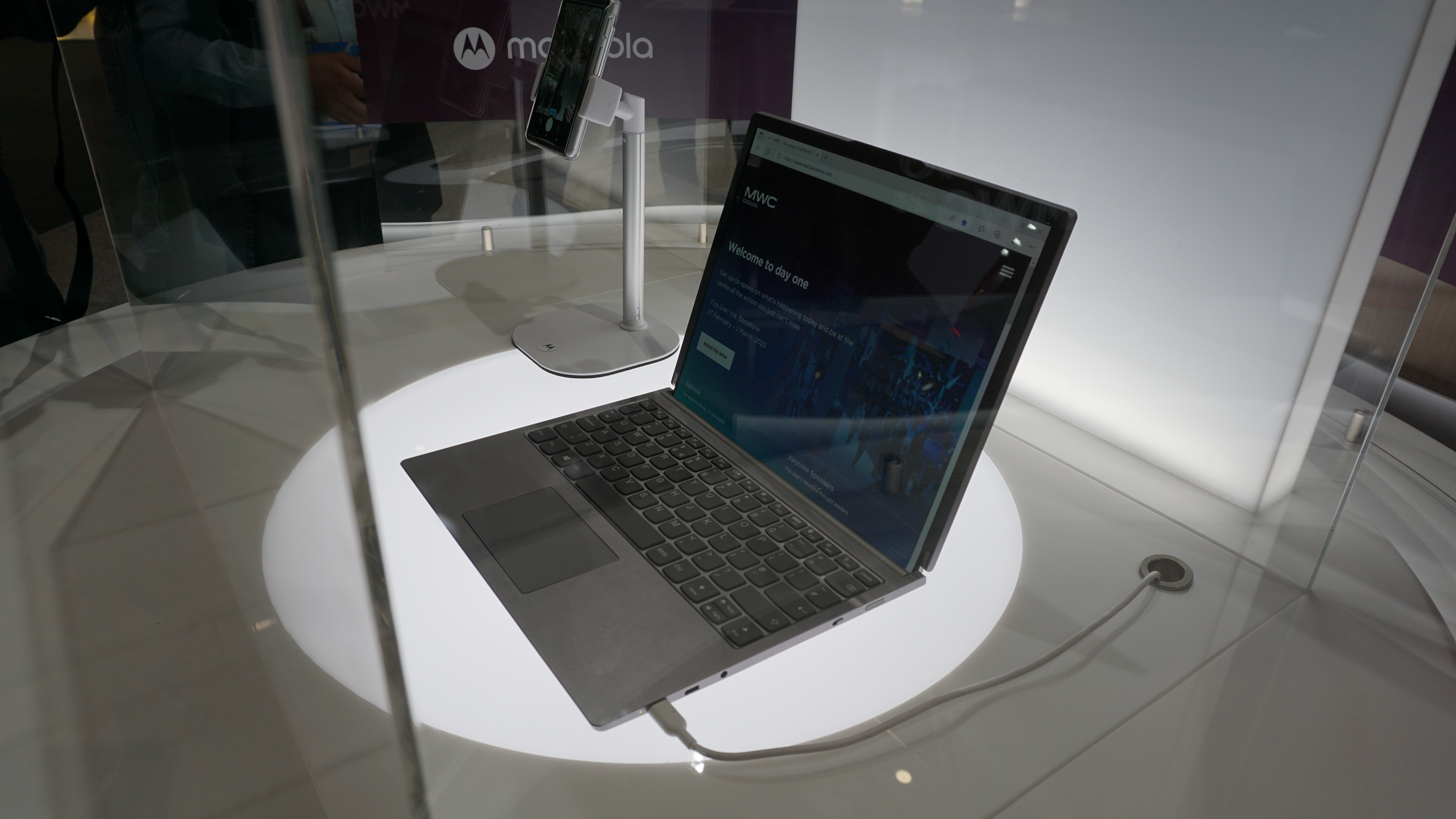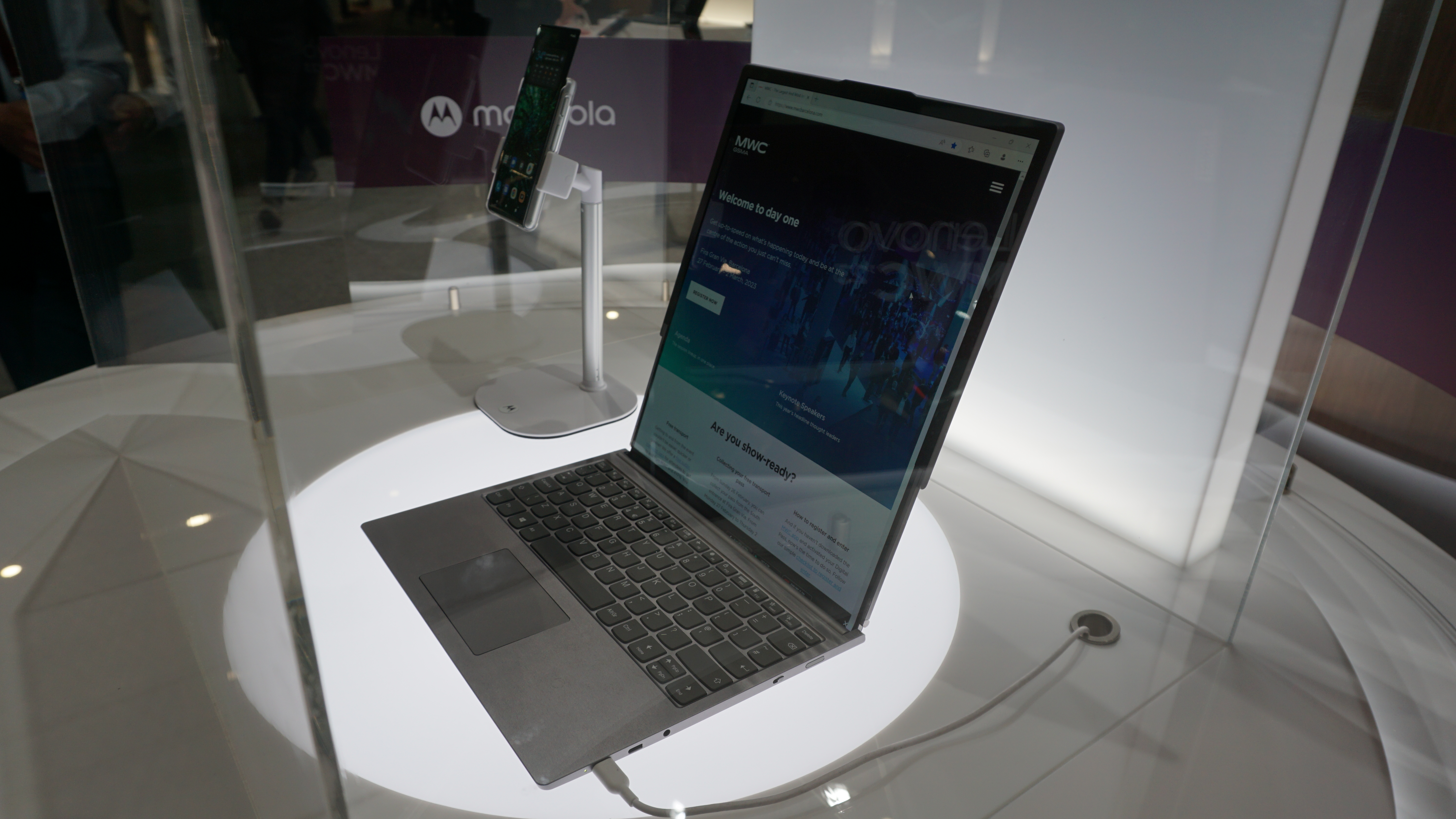By far one of the coolest laptops on show at MWC 2023 in Barcelona right now has to be Lenovo’s ‘rollable technology’ concept unit. As a helpful Lenovo rep informed me, it’s nowhere close to being a marketable product right now - and if I was the person in charge of this particular product, I’d quit while I was ahead.
For starters, I’m going to object to the terminology used here. While the display certainly can be ‘rolled’ to reduce its size, the idea of a ‘rollable’ laptop immediately puts me - and, I would imagine, a lot of people - in mind of a whole device that can be rolled up to make it more compact when not in use. Imagine being able to roll one of the best laptops - or the best phones, since Lenovo also included a compact version of the display - into a nice thin tube to slip into a bag or pocket!
That, sadly, is not what this concept product does. Instead, it features a roll of unused display hidden inside the hinge and a small motor housed within the display casing that can unspool this section of screen to enlarge the whole display. Naturally, this only expands the screen vertically, giving the visual impression that the panel is sliding upwards to reveal more screen space underneath.
It’s certainly an incredible feat of technological engineering, and I can only congratulate Lenovo for making it happen. I think ‘scrollable’ or ‘spoolable’ (is that a real word?) might’ve been a clearer term, though - and that’s not the only problem this new frontier of display tech has.

Needs vs desires
“Your scientists were so preoccupied with whether they could, they didn’t stop to think if they should.” So said Jeff Goldblum (in full leather-clad heartthrob mode) in Jurassic Park, and I think that quote applies here. This is some fantastic technology, but does anyone really need it?
Much like the foldable laptops we’ve seen in recent months, such as the Asus Zenbook 17 Fold OLED, this feels like an exercise in innovation for innovation’s sake. Perhaps that’s cynical of me, but these sorts of products are prohibitively expensive once they make it into full production, and the average consumer simply doesn’t need (or even necessarily want) a laptop that can swap between two different screen sizes.
The recent shift towards 16:10 rather than 16:9 as the productivity aspect ratio of choice has demonstrated that consumers apparently are interested in taller laptop screens rather than wider laptop screens, but this feels like a bridge too far. Fully unspooled (I’m not saying ‘unrolled’), this Lenovo concept laptop is really, really tall - to the point where it feels a bit alien to look at as a regular laptop user.

The limitations of this technology
There are other complications when it comes to displays such as this. While we might be looking at a revolutionary era of flexible displays, the technology still has a way to go - Asus had to make some serious sacrifices to make the Zenbook 17 Fold OLED work without making it ridiculously thick, which included forgoing any ports larger than a USB-C and splitting the battery in two. Everything becomes harder to plan for, from portability to thermal management.
Let us not forget, though, that this isn’t Lenovo’s first dance with flexible display technology. The ThinkPad X1 Fold Gen 2 was a bold reimagining of the company’s iffy original foldable laptop, and I quite liked it in my hands-on review. A big problem with currently available foldable laptops is that they can’t reasonably incorporate a discrete graphics card, which is a shame since they would be very well-suited to digital artists and other creators.
However, this new type of display could bypass that issue. Since the ‘rolled-up’ portion of the display is tucked away at the base of the screen bezel when not in use, the whole bottom portion of the laptop is, well, just like a normal ultrabook. With foldables, manufacturers have to fit all the internal components behind the screen; here, a GPU could be implemented without any particular difficulty.
One big concern with flexible panels is durability; virtually every folding device from phones to tablets has had criticisms leveled at them for being easier to damage than a conventional display. Here, it’s even worse. We’re not just talking about the need for a durable hinge. That spooling display is motorized, which means we’ve got tiny, delicate moving parts around an even more delicate flexible display panel. I don’t mean to be a Negative Nancy here, but that’s asking for trouble.
Perhaps in five years, or ten, or twenty, we’ll be using sexy, flexy screens in every aspect of our lives. But now’s not the time - and while I do respect companies like Lenovo and Asus for pushing the envelope with interesting new designs, we’re not going to see them selling big any time soon.
from TechRadar - All the latest technology news https://ift.tt/1OWVgZm
EmoticonEmoticon